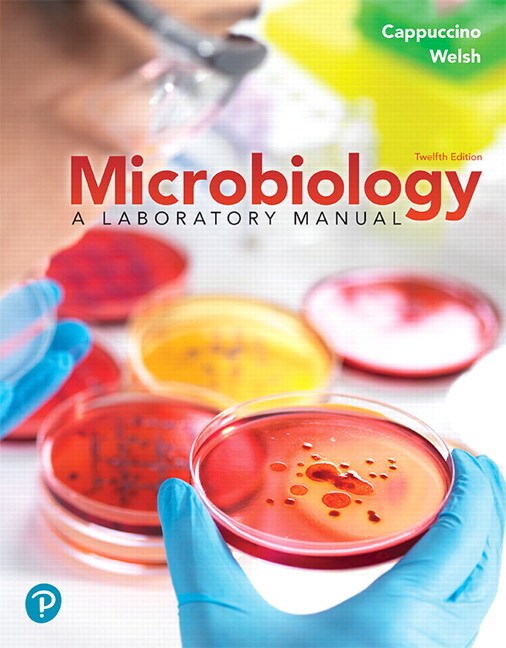
Microbiology: A Laboratory Manual, 12th edition
- James G. Cappuccino
- , Chad T. Welsh

- Find it fast
Quickly navigate your eTextbook with search
- Stay organized
Access all your eTextbooks in one place
- Easily continue access
Keep learning with auto-renew
Microbiology: A Laboratory Manual provides you with a solid underpinning of microbiology laboratory work while putting a strong focus on clinical applications and critical-thinking skills. The lab manual is clear, comprehensive, and versatile and can be easily adapted to virtually any microbiology lab course and paired with any undergraduate microbiology text.
The 12th Edition is extensively updated to enhance your learning experience and to help prepare you for success in the course and your future career. Updates and additions include clinical case studies, equipment and material checklists, new experiments, governing body guidelines and more.
Published by Pearson (June 14th 2021) - Copyright © 2022
ISBN-13: 9780137546527
Subject: Microbiology
Category: Intro Microbiology
Part 1 Basic Laboratory Techniques for Isolation, Cultivation, and Cultural
- Experiment 1: Effectiveness of Hand Washing
- Experiment 2: Culture Transfer Techniques
- Experiment 3: Techniques for Isolation of Pure Cultures
- Experiment 4: Cultural Characteristics of Microorganisms
Part 2 Microscopy
- Experiment 5: Microscopic Examination of Stained Cell Preparations
- Experiment 6:Microscopic Examination of Living Microorganisms Using a Hanging-Drop Preparation or a Wet Mount
Part 3 Bacterial Staining
- Experiment 7: Preparation of Bacterial Smears
- Experiment 8: Simple Staining
- Experiment 9: Negative Staining
- Experiment 10:Gram Stain
- Experiment 11: Acid-Fast Stain
- Experiment 12: Differential Staining for Visualization of Bacterial Cell Structures
Part 4 Cultivation of Microorganisms: Nutritional and Physical Requirements, and Enumeration of Microbial Populations
- Experiment 13:Nutritional Requirements: Media for the Routine Cultivation of Bacteria
- Experiment 14: Use of Differential, Selective, and Enriched Media
- Experiment 15: Physical Factors: Temperature
- Experiment 16: Physical Factors: pH of the Extracellular Environment
- Experiment 17: Physical Factors: Atmospheric Oxygen Requirements
- Experiment 18: Techniques for the Cultivation of Anaerobic Microorganisms
- Experiment 19: Serial Dilution–Agar Plate Procedure to Quantitate Viable Cells
- Experiment 20: The Bacterial Growth Curve
Part 5 Biochemical Activities of Microorganisms
- Experiment 21: Extracellular Enzymatic Activities of Microorganisms
- Experiment 22: Carbohydrate Fermentation
- Experiment 23: Triple Sugar–Iron Agar Test
- Experiment 24: IMViC Test
- Experiment 25: Hydrogen Sulfide Test
- Experiment 26: Urease Test
- Experiment 27: Litmus–Milk Reactions
- Experiment 28: Nitrate Reduction Test
- Experiment 29: Catalase Test
- Experiment 30: Oxidase Test
- Experiment 31: Utilization of Amino Acids
- Experiment 32: Genus Identification of Unknown Bacterial Cultures
Part 6 The Protozoa
- Experiment 33: Free-Living Protozoa
- Experiment 34: Parasitic Protozoa
Part 7 The Fungi
- Experiment 35: Cultivation and Morphology of Molds
- Experiment 36: Isolation of a Soil Fungal Species
- Experiment 37:Morphology, Cultural Characteristics and Reproduction
Part 8 The Viruses
- Experiment 38: Cultivation and Enumeration of Bacteriophages
- Experiment 39: Isolation of Coliphages from Raw Sewage
- Experiment 40: Propagation of Isolated Bacteriophage Cultures
Part 9 Physical and Chemical Agents for the Control of Microbial Growth
- Experiment 41: Physical Agents of Control: Moist Heat
- Experiment 42: Chemical Agents of Control: Chemotherapeutic Agents
- Experiment 43: Determination of Penicillin Activity in the Presence and Absence of Penicillinase
- Experiment 44: Chemical Agents of Control: Disinfectants and Antiseptics
Part 10 Microbiology of Food
- Experiment 45: Microbiological Analysis of Food Products: Bacterial Count
- Experiment 46: Isolation of Salmonella from Raw Meat
- Experiment 47: Microbial Fermentation
PART 11 Microbiology of Water
- Experiment 48: Standard Qualitative Analysis of Water
- Experiment 49: Quantitative Analysis of Water: Membrane Filter Method
PART 12 Microbiology of Soil
- Experiment 50: Microbial Populations in Soil: Enumeration
- Experiment 51: Isolation of Antibiotic-Producing Microorganisms and Determination of Antimicrobial Spectrum of Isolates
- Experiment 52: Isolation of Pseudomonas Species by Means of the Enrichment Culture Technique
PART 13 Bacterial Genetics
- Experiment 53: Enzyme Induction
- Experiment 54: Bacterial Conjugation
- Experiment 55: Isolation of a Streptomycin-Resistant Mutant
- Experiment 56: The Ames Test: A Bacterial Test System for Chemical Carcinogenicity
- Experiment 57: Utilization of Bacterial Plasmids
- Experiment 58: Restriction Analysis and Electrophoretic Separation of Bacteriophage Lambda DNA
PART 14 Medical Microbiology
- Experiment 59: Microbial Flora of the Mouth: Determination of Susceptibility to Dental Caries
- Experiment 60: Normal Microbial Flora of the Throat and Skin
- Experiment 61: Identification of Human Staphylococcal Pathogens
- Experiment 62: Identification of Human Streptococcal Pathogens
- Experiment 63: Identification of Streptococcus pneumoniae
- Experiment 64: Identification of Enteric Microorganisms Using Computer-Assisted Multitest Microsystems
- Experiment 65: Isolation and Presumptive Identification of Campylobacter
- Experiment 66: Microbiological Analysis of Urine Specimens
- Experiment 67: Microbiological Analysis of Blood Specimens
- Experiment 68: Species Identification of Unknown Bacterial Cultures
PART 15 Immunology
- Experiment 69: Precipitin Reaction: The Ring Test
- Experiment 70: Agglutination Reaction: The Febrile Antibody Test
- Experiment 71: Enzyme-Linked Immunosorbent Assay
- Experiment 72: Sexually Transmitted Diseases: Rapid Immunodiagnostic Procedures